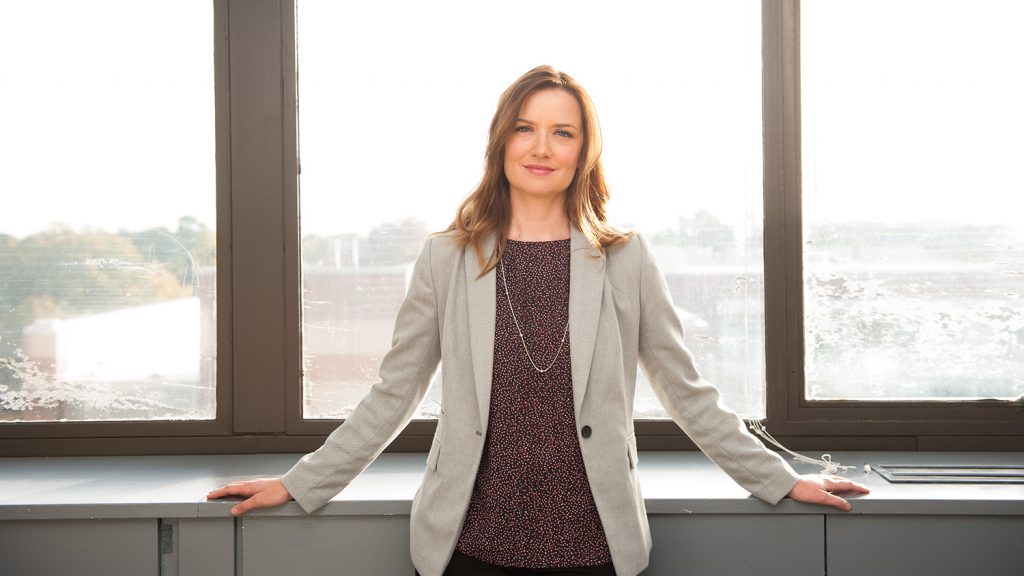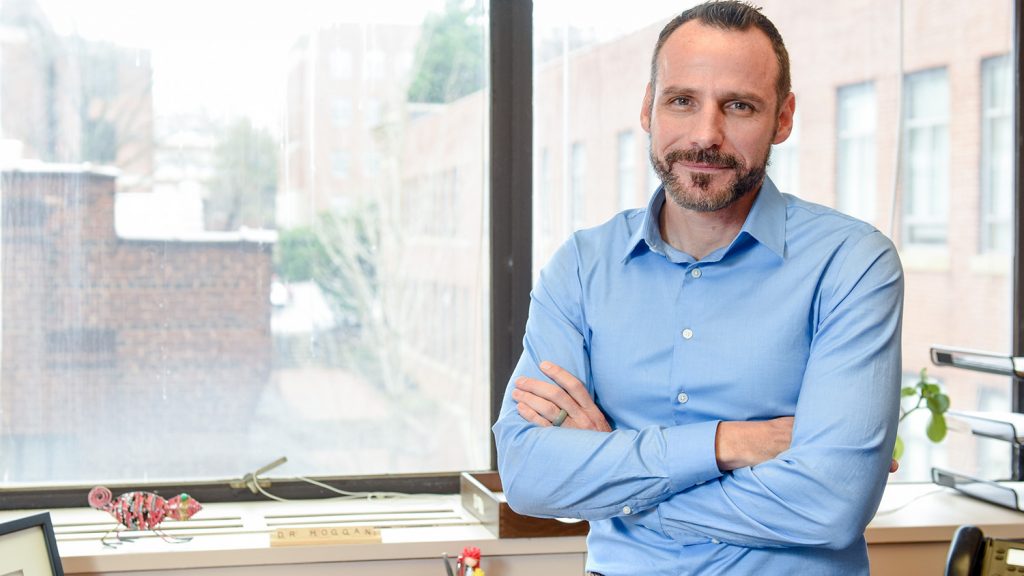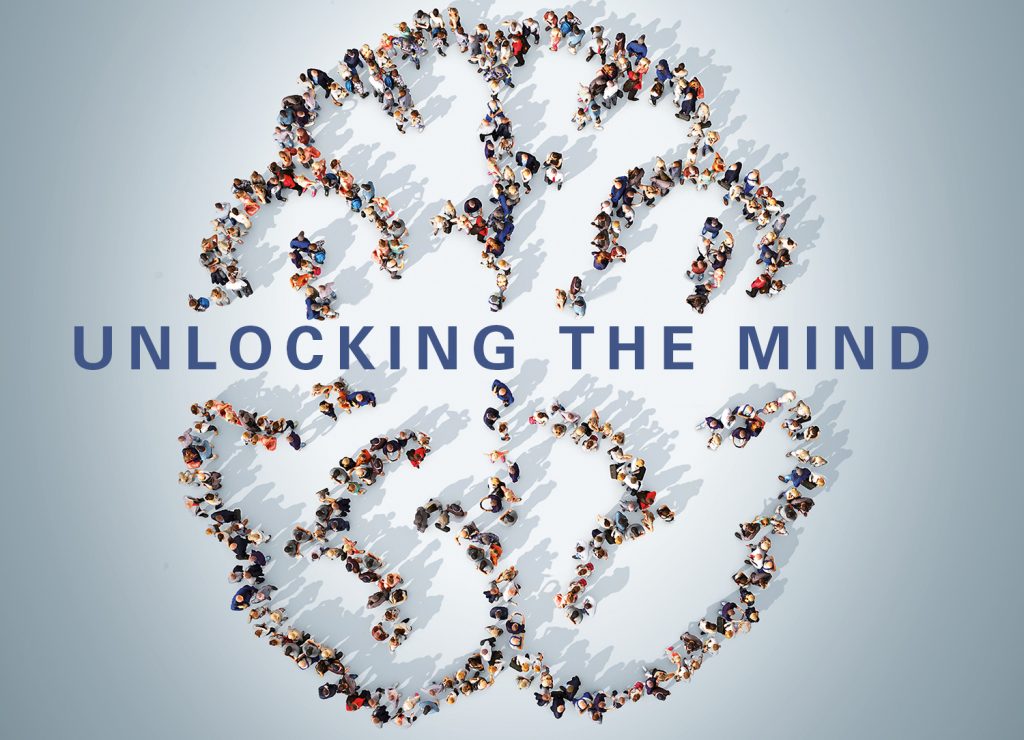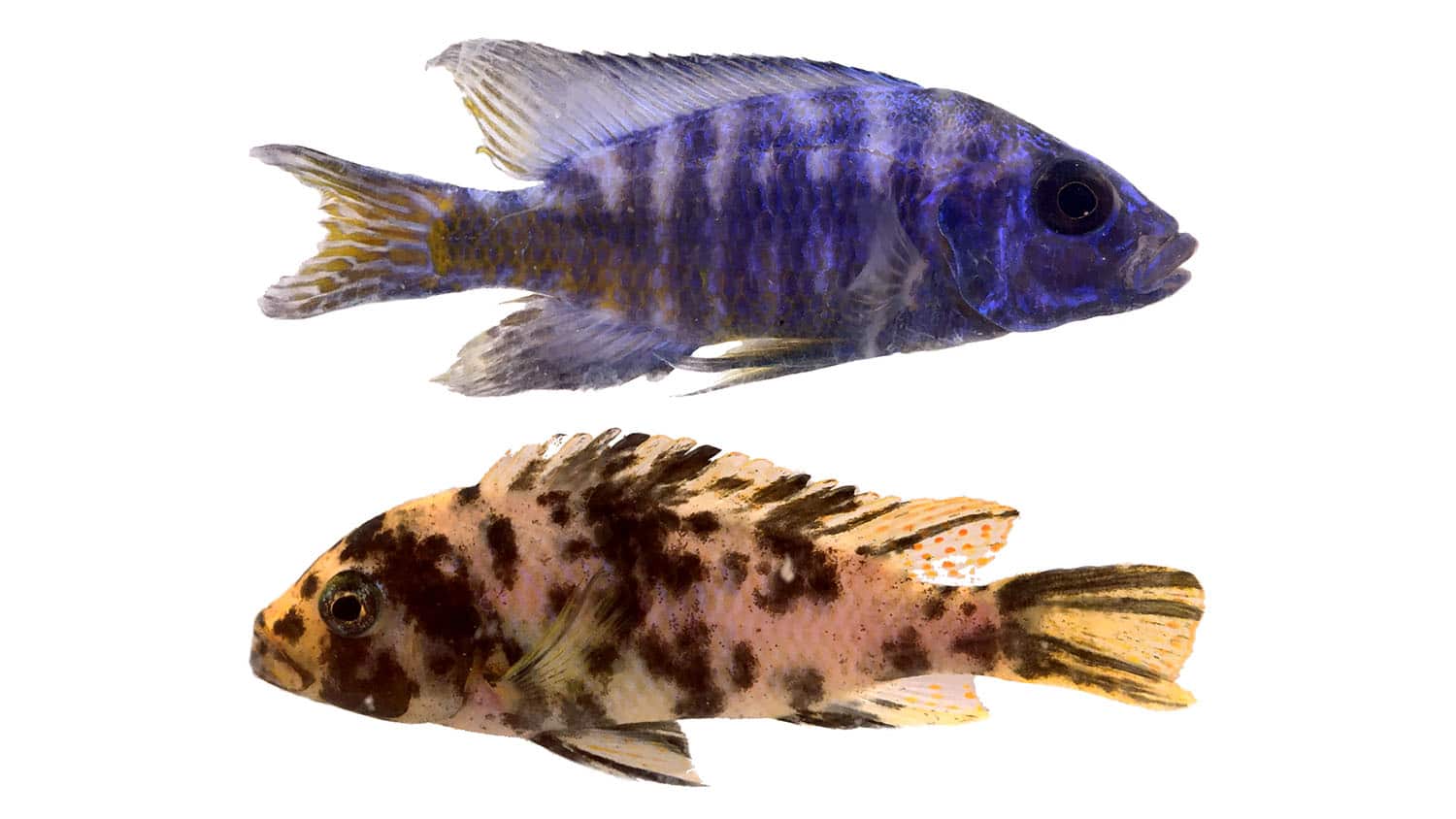Unlocking the Mind
Hidden inside the mind are the answers to some of society’s most vexing problems, from violence and depression to terrorism. Meet the researchers who may hold the key.

Forensic psychologist Sarah Desmarais studies murky topics that are difficult to dissect, such as violence against sexual minorities, drug use among parolees and terrorism.
Her goal is to understand the most complicated subject of all — human behavior — and disseminate her findings to make communities safer and healthier, whether by helping large government agencies craft policy or assisting mental health professionals as they deal with individual cases.
“I came to research wanting it to make a difference,” Desmarais says. “I really think that science can make the world better. That is the most important thing I do.”
Point of intervention
Although Desmarais’ wide variety of research topics might seem to have little in common, they all fall under the umbrellas of public safety and public health. She focuses her research on psychology and the criminal justice system, studying behavior and characteristics of both perpetrators and victims and then translating the resultant data into recommendations.

Mental health forms a key part of Desmarais’ research — specifically its intersection with the criminal justice system. According to the National Alliance on Mental Illness, nearly 15 percent of men and 30 percent of women booked into jails have a serious mental health condition.
15 Percent
of men booked into jails have serious mental health issues
30 Percent
of women booked into jails have serious mental health issues
“I’m really interested in jails as a point of intervention, because this is where we have the highest volume of individuals coming through any part of the criminal justice system in the United States,” Desmarais says. Jails include people convicted of minor crimes as well as people awaiting trial; prisons usually confine people serving sentences for felonies.
“We have more people who pass through jails every year than pass through prison or probation or any other setting,” she notes.
Desmarais’ early work in a jail setting planted the seeds of her research ideas. As a graduate student at Simon Fraser University in Burnaby, Canada, she did jail intake assessments to identify individuals who had mental health or substance abuse problems or who were at risk of harming themselves or others.
“I started thinking about how I would look at the bigger system and policies that are in place that are bringing these people to those experiences — the criminal justice system and my office in the jail,” she says. “How might I be able to effect change on a bigger scale to hopefully interrupt that cycle?”
Her work has influenced agencies and institutions around the country. She has studied suicide, violence and high-risk behavior among veterans for the Department of Veterans Affairs, violence and victimization among adults with mental illness for the National Institute of Mental Health and military workplace violence for the Department of Defense.
Last year Desmarais’ research appeared in publications including the International Journal of Social Psychiatry, Criminal Justice and Behavior and Archives of Women’s Mental Health. Media outlets including the Washington Postand North Carolina Public Radio have sought her expert opinion as a forensic psychologist. The front page of one of her articles even appeared briefly on an episode of Last Week Tonight With John Oliver that dealt with mental health.
In November she went to Indiana to talk to legislators about risk assessment and youth. Closer to home, Desmarais spent a year examining the prevalence of mental health problems in the Wake County Detention Center. The center is implementing some of her recommendations, such as establishing protocols for intake staff to follow when an inmate screens positive on the jail’s brief mental health evaluation. Center staff are also exploring options for diverting detainees with mental health problems to a crisis unit or other community treatment setting.
Desmarais says over the past decade she’s seen an increase in legislation that takes into account findings by forensic psychologists and other social scientists.
She also works with professionals outside the criminal justice setting, such as clinicians and case managers working with people with mental illnesses.
“It’s been a really amazing experience when I get to train people on the front line and give them better tools or even maybe just more confidence in doing very difficult and challenging jobs that many of us wouldn’t be able to do on a daily basis,” Desmarais says. “To have people thank me for helping them feel like they can do their work better — those might be some of the most satisfying and professionally rewarding experiences.
“I try to get information into the hands of people who can use it to improve outcomes. That’s my favorite part of the job.”
Her work with the criminal justice system led her to study an important 21st-century problem: terrorism.
Operating in the shadows
Desmarais didn’t initially set out to study terrorism, but it turns out that the topic provides a natural segue for someone studying violence and criminal behavior.
“Many of us who have done work in violence risk assessment started to be asked questions about how that may translate to looking at the risk of terrorism,” she says.
“It’s been interesting to think about. I view terrorism as a specific type of violence, and there have been some questions and discussion in the field about whether that means there are unique risk factors associated with it. Or is there overlap?”
One factor under review is education. There is a link between low levels of education and risk of violence or criminal behavior, Desmarais says. When it comes to terrorism, there might be higher levels of education but less “vocational success,” she says.
Terrorism presents challenges in finding subjects to study, too. Individuals in the criminal justice system have already been identified through arrest, hospitalization or other means. Terrorists, whether acting as individuals or in groups, operate in the shadows.
“With terrorism, we’re not sure how to cast that net and what information to start with because we don’t have a lot of potential terrorists documented through official ways,” Desmarais says.
She and others are conducting research on terrorism through NC State’s Laboratory for Analytic Sciences, or LAS, which was founded in 2013 in collaboration with the National Security Agency. Desmarais’ terrorism research group includes Chad Hoggan, an assistant professor of educational leadership, policy and human development, and teaching assistant psychology professor Joseph Simons-Rudolph.

Hoggan’s research focuses on transformative learning, which refers to experiences that affect how people see themselves and the world around them. He had just begun creating a typology, or classification system, of transformative learning outcomes when he became involved with LAS several years ago.
“We’ve used my typology to try to understand how different forms of radicalization might emerge from different potential terrorist groups,” Hoggan says. “The typology has been useful for me as an analytic tool to understand how different individuals or groups of people make sense of the world and how they change.”
Hoggan’s background in the field of education informs his approach to the research, which differs from that of his psychologist colleagues.
“They tend to focus on things such as, ‘How can we measure this in some quantifiable way?’ and ‘What are the individual characteristics that would lend themselves to this?’ Whereas I tend to ask, ‘What conditions might promote this type of change, and how can we spot them?’” In other words, what makes someone turn to terrorism—and what can society do about it?
The team’s analysis of existing information on risk factors associated with someone joining a terrorist group or committing an act of terrorism appeared last year in the Journal of Threat Assessment and Management. They found 205 articles on the subject, but only a handful offered useful data and statistical analysis.
“Basically, over the past quarter-century, there have been six research articles that are useful in identifying someone who is likely to engage in terrorism, and the quality of those six studies is variable,” Desmarais says. “There may be classified research I’m not aware of, but this highlights the need for more research in this area.”
Simons-Rudolph, the psychology professor, says the next step is to evaluate current risk assessment tools and protocols used to identify terrorists. He wants to establish a stronger empirical foundation for risk assessment when it comes to terrorism and radicalization so intelligence agents will have more effective tools to use in their investigations.
“This field is in its infancy, and it is very exciting to be a part of the process,” he says.
As well as publishing research in journals and presenting to fellow academics, the researchers are collaborating with LAS on ways to translate their findings into practical applications. They also speak at conferences focused on homeland security at the agency and practitioner levels, sharing their findings and learning what different agencies are doing to fight extremism.
As with her work through LAS, Desmarais uses multiple channels to spread what she knows about terrorism, such as writing white papers and executive summaries for intelligence agencies, and participating in panels to discuss her findings with more diverse audiences.
Assessing risk
One tool Desmarais and other forensic psychologists use in their research and practice is structured risk assessments, which help identify individuals more likely to offend and then outline strategies to minimize the odds. Desmarais has developed her own assessments.
“If I’m known for something, that’s what it is,” she says. She co-wrote the Short-Term Assessment of Risk and Treatability, a clinical guide used in both public and private institutions and practices around the world to help health care and criminal justice professionals handle adults with mental, personality and substance-related disorders.
Desmarais emphasizes the value of interviews when assessing the risk of violence. “One of the things we learn a lot about in psychology is how to ask questions,” she says. Questions should be brief and to the point, she notes, because sometimes the people answering them have trouble focusing due to mental illnesses or other factors.
Establishing trust is also important.
“It’s really about building rapport with the people you’re interviewing and being really sensitive to the story and the information they’re telling you,” Desmarais says. One important variable is whether interviewees answer truthfully. Desmarais says there is little incentive to lie to researchers, especially those with certificates of confidentiality that prevent disclosure of information, even under subpoena. Researchers can also confirm subjects’ stories through official documents, such as court records, and by talking to family members. They also check responses for the presence of social desirability bias — the possibility that people are telling you what they think you want to hear.
Psychologists also learn to identify malingering, or feigning mental health problems, Desmarais says. She remembers talking to a jail inmate who wanted to transfer to the psychiatric hospital simply because smoking was allowed there.
“His ultimate way to try to convince me was to say, ‘Call my mom, she’ll tell you I’m crazy.’ I had that internal dialogue with myself where I thought, ‘If you can tell me to call your mom, you’re probably not crazy.’”

Research in action
Desmarais’ research opens the door to practical solutions. A study she conducted last year found that many veterans who suffer from post-traumatic stress disorder are also more likely to experience “post-traumatic growth,” such as a greater appreciation of life, increased inner strength and awareness of new possibilities. The study measured each veteran’s growth on a scale of zero to 105 and gauged the extent of the growth and how long it took.
“One of the key points here is that there can be real benefit from having military veterans think about their traumatic experiences,” Desmarais says of her findings, which appeared in the journal Military Psychology. “While it may be painful in the short term, it can contribute to their well-being in the long term.”
Another study last year looked at a completely different topic: postpartum mood disorders. About 20 percent of new mothers who experience PPMDs, such as depression and anxiety, did not mention them to health care providers, even though national guidelines tell health care professionals to ask about them. The study, published in Maternal and Child Health Journal, found that women who were unemployed had a history of mental health problems or were experiencing severe symptoms were more likely to report barriers to treatment. This finding shows that women need care and attention after childbirth as well as before.
“We don’t just need to teach women how to develop a birth plan; we need to teach them how to develop a social support plan,” Desmarais says.
In addition to her research, Desmarais is coordinator of the Applied Social and Community Psychology Program in the Department of Psychology. She also teaches, training new generations of psychologists. The Forensic Psychology in the Public Interest lab offers students a glimpse into the work she does. Classes are opportunities for Desmarais to explain what psychology is — and what it is not.
“It’s not just teaching people how to be therapists,” Desmarais says. “It’s incredibly diverse as a discipline.”
This is especially true of her field of forensic psychology.“It’s not the same thing as forensic science or forensic anthropology or disciplines that are within the forensic science sphere that are focused on criminal investigation and evidence,” Desmarais explains. “It’s not criminal profiling. It’s not CSI, it’s not Criminal Minds; it’s this other thing where we look at human behavior as it intersects with the criminal justice system more broadly.”


